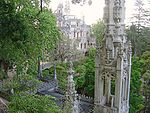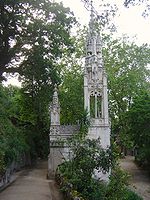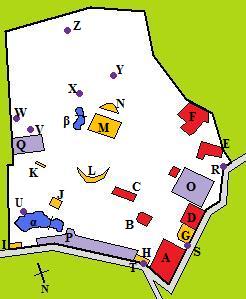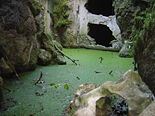
Quinta da Regaleira
Encyclopedia

Sintra
Sintra is a town within the municipality of Sintra in the Grande Lisboa subregion of Portugal. Owing to its 19th century Romantic architecture and landscapes, becoming a major tourist centre, visited by many day-trippers who travel from the urbanized suburbs and capital of Lisbon.In addition to...
, Portugal
Portugal
Portugal , officially the Portuguese Republic is a country situated in southwestern Europe on the Iberian Peninsula. Portugal is the westernmost country of Europe, and is bordered by the Atlantic Ocean to the West and South and by Spain to the North and East. The Atlantic archipelagos of the...
. It is classified as a World Heritage Site
World Heritage Site
A UNESCO World Heritage Site is a place that is listed by the UNESCO as of special cultural or physical significance...
by UNESCO
UNESCO
The United Nations Educational, Scientific and Cultural Organization is a specialized agency of the United Nations...
within the "Cultural Landscape of Sintra". Along with other palaces in this area (such as the Pena, Monserrate
Monserrate Palace
The Monserrate Palace is an exotic palatial villa located near Sintra, Portugal, the traditional summer resort of the Portuguese court. It was built in 1858 for Sir Francis Cook, an English baronet created visconde de Monserrate by King Luís. Monserrate turned to an English architect, James...
and Seteais
Seteais Palace
The Seteais Palace is a neoclassical palace located in Sintra, Portugal. The palace is nowadays a luxury hotel, restaurant and a tourist attraction included in the Cultural Landscape of Sintra, listed as World Heritage Site by UNESCO.-History:...
palaces), it is one of the principal tourist attractions of Sintra. It consists of a romantic
Romanticism
Romanticism was an artistic, literary and intellectual movement that originated in the second half of the 18th century in Europe, and gained strength in reaction to the Industrial Revolution...
palace and chapel, and a luxurious park featuring lakes, grotto
Grotto
A grotto is any type of natural or artificial cave that is associated with modern, historic or prehistoric use by humans. When it is not an artificial garden feature, a grotto is often a small cave near water and often flooded or liable to flood at high tide...
es, wells, benches, fountains, and a vast array of exquisite constructions. The palace is also known as "Palace of Monteiro the Millionaire", from the nickname of its first owner, António Augusto Carvalho Monteiro
António Augusto Carvalho Monteiro
António Augusto Carvalho Monteiro , also known as Monteiro dos Milhões , was born to Portuguese parents in Rio de Janeiro. He inherited a huge family fortune, which he enlarged in Brazil by selling coffee and precious stones, which soon made it possible for him to leave for Portugal...
.
History
The land that is now Quinta da Regaleira had many owners through time. But in 1892 it belonged to the BaronBaron
Baron is a title of nobility. The word baron comes from Old French baron, itself from Old High German and Latin baro meaning " man, warrior"; it merged with cognate Old English beorn meaning "nobleman"...
s of Regaleira, a family of rich merchants from Porto
Porto
Porto , also known as Oporto in English, is the second largest city in Portugal and one of the major urban areas in the Iberian Peninsula. Its administrative limits include a population of 237,559 inhabitants distributed within 15 civil parishes...
, when it was purchased that year by Carvalho Monteiro
António Augusto Carvalho Monteiro
António Augusto Carvalho Monteiro , also known as Monteiro dos Milhões , was born to Portuguese parents in Rio de Janeiro. He inherited a huge family fortune, which he enlarged in Brazil by selling coffee and precious stones, which soon made it possible for him to leave for Portugal...
for 25,000 réi
Portuguese real
The real was the unit of currency of Portugal from around 1430 until 1911. It replaced the dinheiro at the rate of 1 real = 840 dinheiros and was itself replaced by the escudo at a rate of 1 escudo = 1000 réis...
s. Monteiro wished to build a bewildering place where he could gather symbols that would reflect his interests and ideologies. With the assistance of the Italian
Italy
Italy , officially the Italian Republic languages]] under the European Charter for Regional or Minority Languages. In each of these, Italy's official name is as follows:;;;;;;;;), is a unitary parliamentary republic in South-Central Europe. To the north it borders France, Switzerland, Austria and...
architect Luigi Manini
Luigi Manini
Luigi Manini, Count of Fagagna was a European set designer and architect. He was born in Crema, Italy, and studied at the Brera Academy before becoming an assistant to Carlo Ferrario, the professor of stage design at La Scala...
, he designed the 4-hectare estate with its enigmatic buildings, believed to hide symbols related to alchemy
Alchemy
Alchemy is an influential philosophical tradition whose early practitioners’ claims to profound powers were known from antiquity. The defining objectives of alchemy are varied; these include the creation of the fabled philosopher's stone possessing powers including the capability of turning base...
, Masonry
Freemasonry
Freemasonry is a fraternal organisation that arose from obscure origins in the late 16th to early 17th century. Freemasonry now exists in various forms all over the world, with a membership estimated at around six million, including approximately 150,000 under the jurisdictions of the Grand Lodge...
, the Knights Templar
Knights Templar
The Poor Fellow-Soldiers of Christ and of the Temple of Solomon , commonly known as the Knights Templar, the Order of the Temple or simply as Templars, were among the most famous of the Western Christian military orders...
, and the Rosicrucian
Rosicrucian
Rosicrucianism is a philosophical secret society, said to have been founded in late medieval Germany by Christian Rosenkreuz. It holds a doctrine or theology "built on esoteric truths of the ancient past", which, "concealed from the average man, provide insight into nature, the physical universe...
s. The architecture of the estate evokes Roman
Roman architecture
Ancient Roman architecture adopted certain aspects of Ancient Greek architecture, creating a new architectural style. The Romans were indebted to their Etruscan neighbors and forefathers who supplied them with a wealth of knowledge essential for future architectural solutions, such as hydraulics...
, Gothic
Gothic architecture
Gothic architecture is a style of architecture that flourished during the high and late medieval period. It evolved from Romanesque architecture and was succeeded by Renaissance architecture....
, Renaissance
Renaissance architecture
Renaissance architecture is the architecture of the period between the early 15th and early 17th centuries in different regions of Europe, demonstrating a conscious revival and development of certain elements of ancient Greek and Roman thought and material culture. Stylistically, Renaissance...
and Manueline
Manueline
The Manueline, or Portuguese late Gothic, is the sumptuous, composite Portuguese style of architectural ornamentation of the first decades of the 16th century, incorporating maritime elements and representations of the discoveries brought from the voyages of Vasco da Gama and Pedro Álvares Cabral...
architectural styles. The construction of the current estate commenced in 1904 and most of it was concluded by 1910.
The estate was sold in 1942 to Waldemar d'Orey, who used it as private residence for his extensive family and ordered repairs and restoration works for the property. In 1987 the estate was sold once again, to the Japanese
Japan
Japan is an island nation in East Asia. Located in the Pacific Ocean, it lies to the east of the Sea of Japan, China, North Korea, South Korea and Russia, stretching from the Sea of Okhotsk in the north to the East China Sea and Taiwan in the south...
Aoki Corporation and ceased to serve as a residence. The Aoki Corporation kept the estate closed to the public for ten years, until it was acquired by the Sintra Town Hall in 1997. Extensive restoration was promptly initiated throughout the estate, which opened to the public in June 1998. Cultural events also start to be organized in Quinta da Regaleira. In August that year, the Portuguese Ministry of Culture classified the estate as "public interest property".
Palace
The Regaleira Palace bears the same name as the whole estate. Sometimes, the name "Regaleira Palace" is used to refer to the entire estate.The façade
Facade
A facade or façade is generally one exterior side of a building, usually, but not always, the front. The word comes from the French language, literally meaning "frontage" or "face"....
is characterized by exuberantly Gothic pinnacle
Pinnacle
A pinnacle is an architectural ornament originally forming the cap or crown of a buttress or small turret, but afterwards used on parapets at the corners of towers and in many other situations. The pinnacle looks like a small spire...
s, gargoyle
Gargoyle
In architecture, a gargoyle is a carved stone grotesque, usually made of granite, with a spout designed to convey water from a roof and away from the side of a building thereby preventing rainwater from running down masonry walls and eroding the mortar between...
s, capital
Capital (architecture)
In architecture the capital forms the topmost member of a column . It mediates between the column and the load thrusting down upon it, broadening the area of the column's supporting surface...
s, and an impressive octagonal tower.
The palace has five floors (a ground floor, three upper floors and a basement
Basement
__FORCETOC__A basement is one or more floors of a building that are either completely or partially below the ground floor. Basements are typically used as a utility space for a building where such items as the furnace, water heater, breaker panel or fuse box, car park, and air-conditioning system...
). The ground floor contains a series of hallways connecting the living room, dining room, billiards
Billiards
Cue sports , also known as billiard sports, are a wide variety of games of skill generally played with a cue stick which is used to strike billiard balls, moving them around a cloth-covered billiards table bounded by rubber .Historically, the umbrella term was billiards...
room, balcony, some smaller rooms and several stairways. In turn, the first upper floor contains bedrooms (Carvalho Monteiro's bedroom used to be the one with a balcony) and a dressing room. The second upper floor contains Carvalho Monteiro's office, and female servants' bedrooms. The third upper floor contains the ironing
Iron (appliance)
A clothes iron, also referred to as simply an iron, is a small appliance used in ironing to remove wrinkles from fabric.Ironing works by loosening the ties between the long chains of molecules that exist in polymer fiber materials. With the heat and the weight of the ironing plate, the fibers are...
room and a smaller room with access to a terrace
Terrace (building)
A terrace is an outdoor, occupiable extension of a building above ground level. Although its physical characteristics may vary to a great degree, a terrace will generally be larger than a balcony and will have an "open-top" facing the sky...
. Finally, the basement contains the male servants' bedrooms, the kitchen (which possessed an elevator for lifting food to the ground floor), and storage rooms.
Chapel


Chapel
A chapel is a building used by Christians as a place of fellowship and worship. It may be part of a larger structure or complex, such as a church, college, hospital, palace, prison or funeral home, located on board a military or commercial ship, or it may be an entirely free-standing building,...
stands in front of the palace's main façade. Its architecture is akin to the palace's. The interior of this Roman Catholic temple is richly decorated with fresco
Fresco
Fresco is any of several related mural painting types, executed on plaster on walls or ceilings. The word fresco comes from the Greek word affresca which derives from the Latin word for "fresh". Frescoes first developed in the ancient world and continued to be popular through the Renaissance...
es, stained glass windows and lavish stucco
Stucco
Stucco or render is a material made of an aggregate, a binder, and water. Stucco is applied wet and hardens to a very dense solid. It is used as decorative coating for walls and ceilings and as a sculptural and artistic material in architecture...
es. On the frescoes are represented Teresa of Ávila
Teresa of Ávila
Saint Teresa of Ávila, also called Saint Teresa of Jesus, baptized as Teresa Sánchez de Cepeda y Ahumada, was a prominent Spanish mystic, Roman Catholic saint, Carmelite nun, and writer of the Counter Reformation, and theologian of contemplative life through mental prayer...
and Saint Anthony
Anthony of Padua
Anthony of Padua or Anthony of Lisbon, O.F.M., was a Portuguese Catholic priest and friar of the Franciscan Order. Though he died in Padua, Italy, he was born to a wealthy family in Lisbon, Portugal, which is where he was raised...
, as well as other religious depictions. The floor contains representations of the armillary sphere
Armillary sphere
An armillary sphere is a model of objects in the sky , consisting of a spherical framework of rings, centred on Earth, that represent lines of celestial longitude and latitude and other astronomically important features such as the ecliptic...
of the Portuguese discoveries
Portuguese discoveries
Portuguese discoveries is the name given to the intensive maritime exploration by the Portuguese during the 15th and 16th centuries. Portuguese sailors were at the vanguard of European overseas exploration, discovering and mapping the coasts of Africa, Asia and Brazil, in what become known as the...
and the Order of Christ Cross
Order of Christ Cross
The Order of Christ Cross, or simply the Christ Cross, is the emblem of the historical Portuguese Order of Christ...
, surrounded by pentagram
Pentagram
A pentagram is the shape of a five-pointed star drawn with five straight strokes...
s. Despite its size, the chapel has several floors.
Park

Primitivism
Primitivism is a Western art movement that borrows visual forms from non-Western or prehistoric peoples, such as Paul Gauguin's inclusion of Tahitian motifs in paintings and ceramics...
. Decorative, symbolic and leisure structures can be found everywhere throughout the park, all located within a few minutes walk from the palace.
Tunnels
The park contains an extensive and enigmatic system of tunnels, which have multiple accesses including the grottoes, the chapel, the Waterfall Lake, and the "Leda's Cave" beneath the Regaleira Tower. Their symbolism has been interpreted as a trip between darkness and light, death and resurrection.Lakes, Fountains and the Aquarium

Trivia
Fadista Mariza shot her video for "Cavaleiro Monge" at the palace and its grounds.Quinta da Regaleira is referenced in José Rodrigues dos Santos' book "Codex 632"
See also
- Sintra National PalaceSintra National PalaceThe Sintra National Palace , also called Town Palace is located in the town of Sintra, in Portugal near Lisbon....
- Pena National PalacePena National PalaceThe Pena National Palace is a Romanticist palace in São Pedro de Penaferrim, municipality of Sintra, Portugal. The palace stands on the top of a hill above the town of Sintra, and on a clear day it can be easily seen from Lisbon and much of its metropolitan area. It is a national monument and...
- Queluz National PalaceQueluz National PalaceThe Queluz National Palace is a Portuguese 18th-century palace located at Queluz, a freguesia of the modern-day Sintra Municipality, in the Lisbon District. One of the last great Rococo buildings to be designed in Europe, the palace was conceived as a summer retreat for Dom Pedro of Braganza,...
- Monserrate PalaceMonserrate PalaceThe Monserrate Palace is an exotic palatial villa located near Sintra, Portugal, the traditional summer resort of the Portuguese court. It was built in 1858 for Sir Francis Cook, an English baronet created visconde de Monserrate by King Luís. Monserrate turned to an English architect, James...
- Seteais PalaceSeteais PalaceThe Seteais Palace is a neoclassical palace located in Sintra, Portugal. The palace is nowadays a luxury hotel, restaurant and a tourist attraction included in the Cultural Landscape of Sintra, listed as World Heritage Site by UNESCO.-History:...
External links
- Quinta da Regaleira homepage
- Portugal Virtual
- Sintra Town Hall (PortuguesePortuguese languagePortuguese is a Romance language that arose in the medieval Kingdom of Galicia, nowadays Galicia and Northern Portugal. The southern part of the Kingdom of Galicia became independent as the County of Portugal in 1095...
) - Portuguese Institute for the Architectonic Heritage (PortuguesePortuguese languagePortuguese is a Romance language that arose in the medieval Kingdom of Galicia, nowadays Galicia and Northern Portugal. The southern part of the Kingdom of Galicia became independent as the County of Portugal in 1095...
) - Quinta da Regaleira

